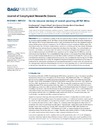Please use this identifier to cite or link to this item:
https://accedacris.ulpgc.es/handle/10553/49041
| DC Field | Value | Language |
|---|---|---|
| dc.contributor.author | Benazzouz, Aïssa | en_US |
| dc.contributor.author | Pelegrí Llopart,José Luis | en_US |
| dc.contributor.author | Demarcq, Herve | en_US |
| dc.contributor.author | Machin, Francisco | en_US |
| dc.contributor.author | Mason, Evan | en_US |
| dc.contributor.author | Orbi, Abdellatif | en_US |
| dc.contributor.author | Peña-Izquierdo, Jesus | en_US |
| dc.contributor.author | Soumia, Mordane | en_US |
| dc.contributor.other | Mason, Evan | - |
| dc.contributor.other | Machin, Francisco | - |
| dc.contributor.other | ORBI, ABDELLATIF | - |
| dc.contributor.other | Pelegri, Josep L. | - |
| dc.contributor.other | Pena-Izquierdo, Jesus | - |
| dc.date.accessioned | 2018-11-24T03:26:14Z | - |
| dc.date.available | 2018-11-24T03:26:14Z | - |
| dc.date.issued | 2014 | en_US |
| dc.identifier.issn | 2169-9275 | en_US |
| dc.identifier.uri | https://accedacris.ulpgc.es/handle/10553/49041 | - |
| dc.description.abstract | We use a combination of satellite, in situ, and numerical data to provide a comprehensive view of the seasonal coastal upwelling cycle off NW Africa in terms of both wind forcing and sea surface temperature (SST) response. Wind forcing is expressed in terms of both instantaneous (local) and time‐integrated (nonlocal) indices, and the ocean response is expressed as the SST difference between coastal and offshore waters. The classical local index, the cross‐shore Ekman transport, reproduces reasonably well the time‐latitude distribution of SST differences but with significant time lags at latitudes higher than Cape Blanc. Two nonlocal indices are examined. One of them, a cumulative index calculated as the backward averaged Ekman transport that provides the highest correlation with SST differences, reproduces well the timing of the SST differences at all latitudes (except near Cape Blanc). The corresponding time lags are close to zero south of Cape Blanc and range between 2 and 4 months at latitudes between Cape Blanc and the southern Gulf of Cadiz. The results are interpreted based on calculations of spatial and temporal auto and cross correlations for wind forcing and SST differences. At temporal scales of 2–3 weeks, the alongshore advection of alongshore momentum compensates for interfacial friction, allowing the upwelling jet and associated frontal system to remain active. We conclude that the coastal jet plays a key role in maintaining the structure of coastal upwelling, even at times of relaxed winds, by introducing a seasonal memory to the system in accordance with the atmospheric‐forcing annual cycle. | en_US |
| dc.language | eng | en_US |
| dc.publisher | 2169-9275 | |
| dc.relation.ispartof | Journal of geophysical research. Oceans | en_US |
| dc.source | Journal Of Geophysical Research-Oceans [ISSN 2169-9275], v. 119 (9), p. 6356-6380 | en_US |
| dc.subject | 251007 Oceanografía física | en_US |
| dc.subject.other | NW Africa | en_US |
| dc.subject.other | Coastal upwelling | en_US |
| dc.subject.other | Ekman transport | en_US |
| dc.subject.other | SST difference | en_US |
| dc.subject.other | Temporal memory | en_US |
| dc.title | On the temporal memory of coastal upwelling off NW Africa | en_US |
| dc.type | info:eu-repo/semantics/article | es |
| dc.type | Article | es |
| dc.identifier.doi | 10.1002/2013JC009559 | en_US |
| dc.identifier.scopus | 84927658592 | - |
| dc.identifier.isi | 000343879200044 | - |
| dcterms.isPartOf | Journal Of Geophysical Research-Oceans | |
| dcterms.source | Journal Of Geophysical Research-Oceans[ISSN 2169-9275],v. 119 (9), p. 6356-6380 | |
| dc.contributor.authorscopusid | 34876226600 | - |
| dc.contributor.authorscopusid | 7003869003 | - |
| dc.contributor.authorscopusid | 6602262969 | - |
| dc.contributor.authorscopusid | 6602804374 | - |
| dc.contributor.authorscopusid | 35264466500 | - |
| dc.contributor.authorscopusid | 55409027900 | - |
| dc.contributor.authorscopusid | 55246098700 | - |
| dc.contributor.authorscopusid | 56593175100 | - |
| dc.description.lastpage | 6380 | - |
| dc.description.firstpage | 6356 | - |
| dc.relation.volume | 119 | - |
| dc.investigacion | Ciencias | en_US |
| dc.type2 | Artículo | en_US |
| dc.contributor.daisngid | 5506165 | - |
| dc.contributor.daisngid | 358123 | - |
| dc.contributor.daisngid | 1103657 | - |
| dc.contributor.daisngid | 1451397 | - |
| dc.contributor.daisngid | 1414204 | - |
| dc.contributor.daisngid | 2309784 | - |
| dc.contributor.daisngid | 6966487 | - |
| dc.contributor.daisngid | 20140972 | - |
| dc.identifier.investigatorRID | A-5101-2019 | - |
| dc.identifier.investigatorRID | A-9287-2009 | - |
| dc.identifier.investigatorRID | No ID | - |
| dc.identifier.investigatorRID | No ID | - |
| dc.identifier.investigatorRID | No ID | - |
| dc.utils.revision | Sí | en_US |
| dc.identifier.ulpgc | Sí | es |
| dc.description.jcr | 3,426 | |
| dc.description.jcrq | Q1 | |
| item.fulltext | Con texto completo | - |
| item.grantfulltext | open | - |
| crisitem.author.dept | GIR ECOAQUA: Oceanografía Física y Geofísica Aplicada | - |
| crisitem.author.dept | IU de Investigación en Acuicultura Sostenible y Ec | - |
| crisitem.author.dept | Departamento de Física | - |
| crisitem.author.orcid | 0000-0002-4281-6804 | - |
| crisitem.author.parentorg | IU de Investigación en Acuicultura Sostenible y Ec | - |
| crisitem.author.fullName | Pelegrí Llopart, José Luis | - |
| crisitem.author.fullName | Machín Jiménez, Francisco José | - |
| Appears in Collections: | Artículos | |
SCOPUSTM
Citations
27
checked on Jun 8, 2025
WEB OF SCIENCETM
Citations
25
checked on Jun 8, 2025
Page view(s)
100
checked on Oct 5, 2024
Download(s)
166
checked on Oct 5, 2024
Google ScholarTM
Check
Altmetric
Share
Export metadata
Items in accedaCRIS are protected by copyright, with all rights reserved, unless otherwise indicated.
